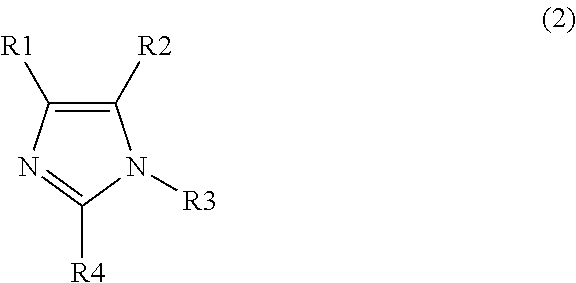Polymerizable composition, optical material, and manufacturing method of the same
a technology of polymerizable composition and optical material, which is applied in the direction of spectales/goggles, instruments, other domestic articles, etc., can solve the problems of reducing the yield of products in some cases, and affecting the performance of optical materials, and achieve excellent optical characteristics such as refractive index
- Summary
- Abstract
- Description
- Claims
- Application Information
AI Technical Summary
Benefits of technology
Problems solved by technology
Method used
Image
Examples
example 1
[0145]2.00 g of 1,2-dimethylimidazole as a catalyst was added to 8.00 g of Zelec UN (acidic phosphoric acid ester: registered trademark, manufactured by Stepan Company) as an internal release agent, and the components were mixed and dissolved together at room temperature until a uniform solution was formed, thereby preparing a catalyst / release agent master liquid. Furthermore, 49.50 g of bis(4-isocyanatocyclohexyl)methane was mixed with 8.74 g of 2,5(6)-bis(isocyanatomethyl)-bicyclo[2.2.1]heptane, and to this mixture, 1.50 g of Biosorb 583 as an ultraviolet absorber and 0.18 g of the catalyst / release agent master liquid prepared as above were added. These components were mixed and dissolved together at 20° C., thereby preparing a uniform solution. After the dissolution, 37.59 g of 4-mercaptomethyl-1,8-dimercapto-3,6-dithiaoctane and 4.17 g of diethylene glycol dimercaptopropionate were added thereto, and the components were mixed and dissolved together at 20° C., thereby preparing a...
example 2
[0146]3.33 g of 1-benzyl-2-methylimidazole as a catalyst was added to 6.67 g of Zelec UN as an internal release agent, and the components were mixed and dissolved together at room temperature until a uniform solution was formed, thereby preparing a catalyst / release agent master liquid. A lens was obtained by performing polymerization in the same manner as in Example 1, except that 49.50 g of bis(4-isocyanatocyclohexyl)methane was mixed with 8.74 g of 2,5(6)-bis(isocyanatomethyl)-bicyclo[2.2.1]heptane; 1.50 g of Biosorb 583 as an ultraviolet absorber and 0.15 g of the catalyst / release agent master liquid prepared as above were added to the mixture; and the components were mixed and dissolved together at 20° C. The results of the performance evaluation of the obtained lens are summarized in Table 1.
example 3
[0147]1.00 g of 1,2-dimethylimidazole and 1.66 g of 1-benzyl-2-methylimidazole as catalyst were added to 7.34 g of Zelec UN as an internal release agent, and the components were mixed and dissolved together at room temperature until a uniform solution was formed, thereby preparing a catalyst / release agent master liquid. A lens was obtained by performing polymerization in the same manner as in Example 1, except that 49.50 g of bis(4-isocyanatocyclohexyl)methane was mixed with 8.74 g of 2,5(6)-bis(isocyanatomethyl)-bicyclo[2.2.1]heptane; 1.50 g of Biosorb 583 as an ultraviolet absorber and 0.25 g of the catalyst / release agent master liquid prepared as above were added to the mixture; and the components were mixed and dissolved together at 20° C. The results of the performance evaluation of the obtained lens are summarized in Table 1.
PUM
| Property | Measurement | Unit |
|---|---|---|
| Fraction | aaaaa | aaaaa |
| Fraction | aaaaa | aaaaa |
Abstract
Description
Claims
Application Information
 Login to View More
Login to View More - R&D
- Intellectual Property
- Life Sciences
- Materials
- Tech Scout
- Unparalleled Data Quality
- Higher Quality Content
- 60% Fewer Hallucinations
Browse by: Latest US Patents, China's latest patents, Technical Efficacy Thesaurus, Application Domain, Technology Topic, Popular Technical Reports.
© 2025 PatSnap. All rights reserved.Legal|Privacy policy|Modern Slavery Act Transparency Statement|Sitemap|About US| Contact US: help@patsnap.com



